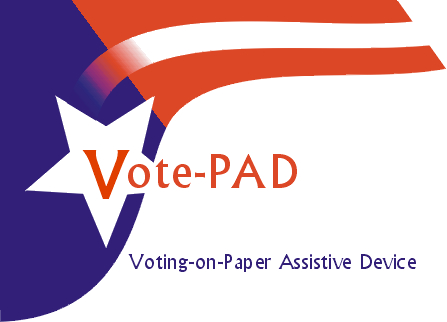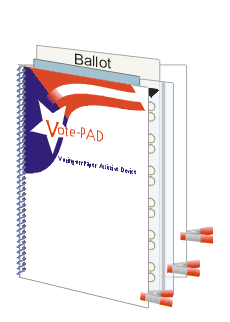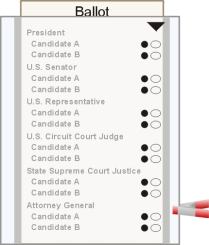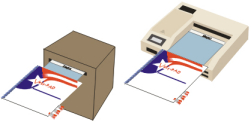|
|
|
|
Accessible Voting Without Computers A Little Background Some people with visual or dexterity impairments cannot mark a paper ballot without assistance. The Federal Help America Vote Act of 2002 (HAVA) requires that every polling place must offer a method by which people with disabilities can vote independently. Electronic voter-assist devices provide help to certain disabled voters, however many such machines fail to provide comprehensive assistance for dexterity impaired voters. Furthermore, all electronic voter-assist products are expensive to acquire, store, and maintain. Only a portion of the acquisition cost is funded by federal HAVA money. The Problem To their surprise, many jurisdictions that already use computerized voting equipment are finding that there are no HAVA-compliant electronic options compatible with their current systems. They need a compliant device quickly, if only as an interim solution. Paper-ballot jurisdictions that do not want to or cannot afford to computerize their election systems need a non-computerized method of providing private and independent voting for voters with disabilities. All jurisdictions need to provide independent voting on paper provisional ballots and back-up paper ballots.
Supplementing existing voter-assist methods with Vote-PADs is a responsible way of ensuring accessible provisional voting and voting during breakdowns.
An opaque, sliding “privacy shield” sits in a pocket inside the front cover and slides part-way out to conceal the ballot as it is being deposited in a ballot box or precinct scanner.
The ballot for each election in each jurisdiction is unique. Because each sleeve is specifically constructed to match a unique ballot sheet, the Vote-PAD is custom built for each ballot. Therefore, production of each Vote-PAD is designed to be inexpensive so that the Vote-PADs can be recycled or discarded after each election. Vote-PADs can be constructed by hand with readily available materials. Or, they can be manufactured at a fraction of the cost of computerized voter-assist methods. Contact us for more information. Download and print a tri-fold brochure (148 KB). View an explanation of how disabled individuals use the Vote-PAD. Examine a comparison of the Vote-PAD costs with the costs of electronic equipment (75 KB). Read what eight of the many people who tested for us said about the Vote-PAD (103 KB). Learn about the company and the participants. The Vote-PAD was developed in cooperation with both dexterity- and visually-impaired individuals, whose advice and suggestions we gratefully included in the design. Patent Pending |




